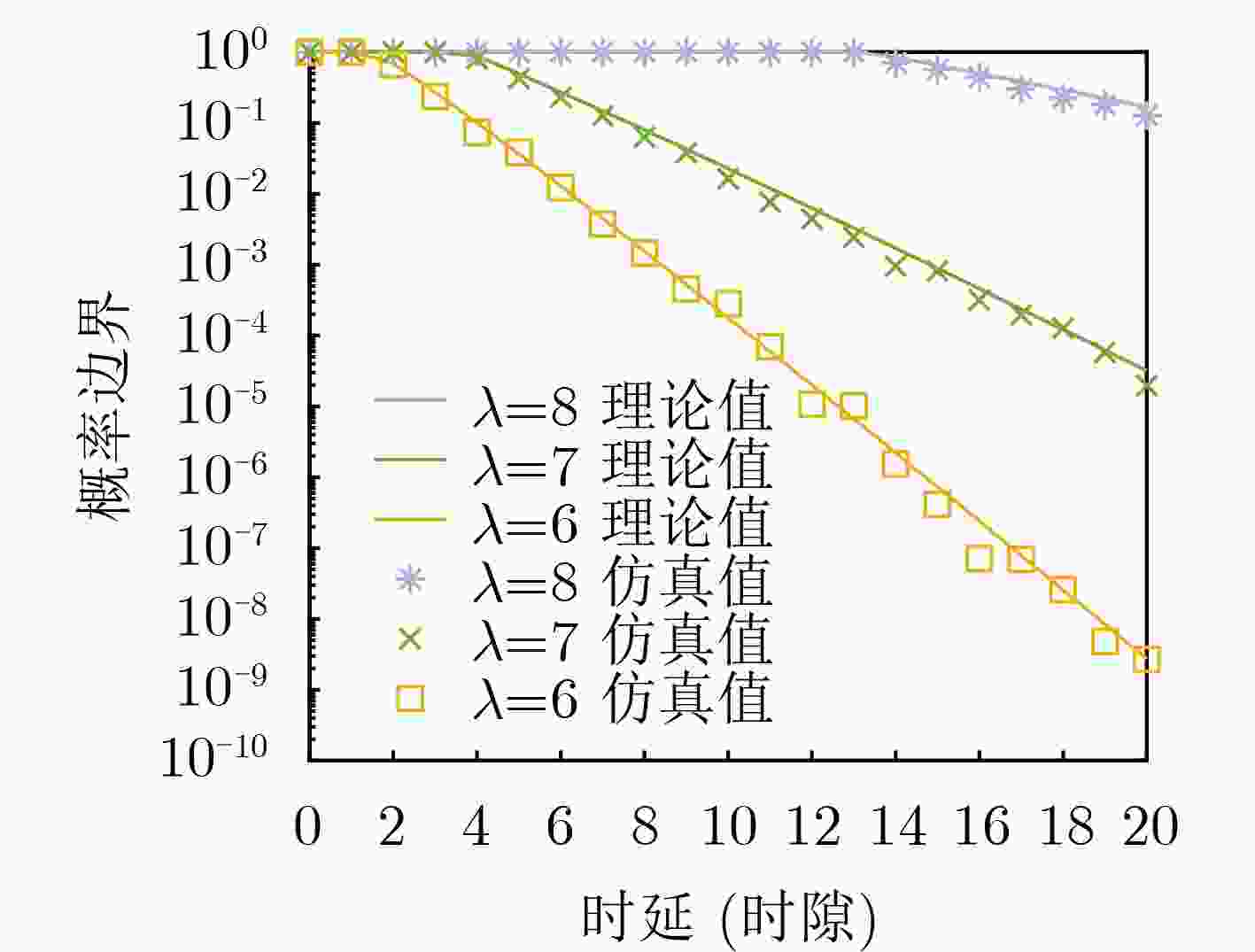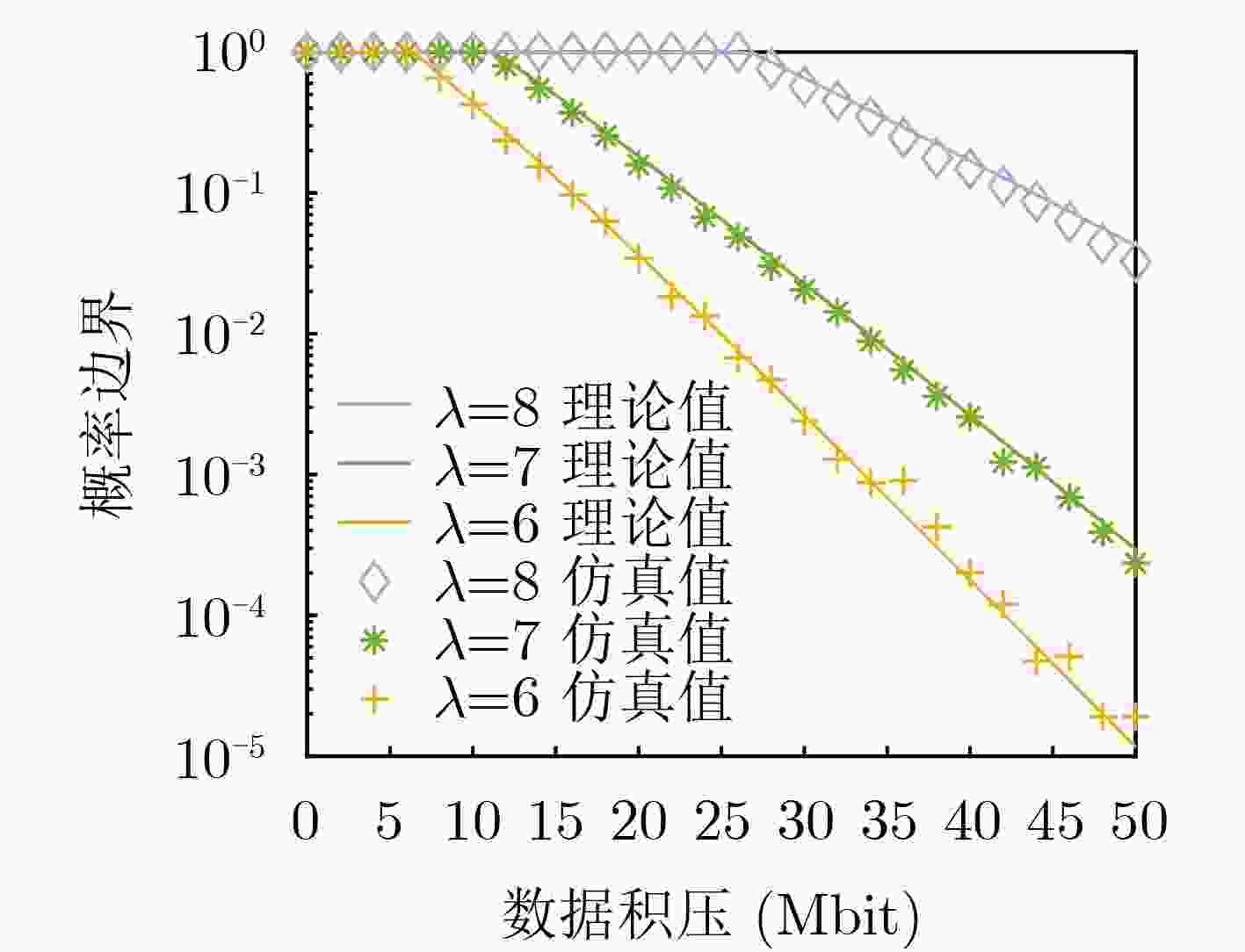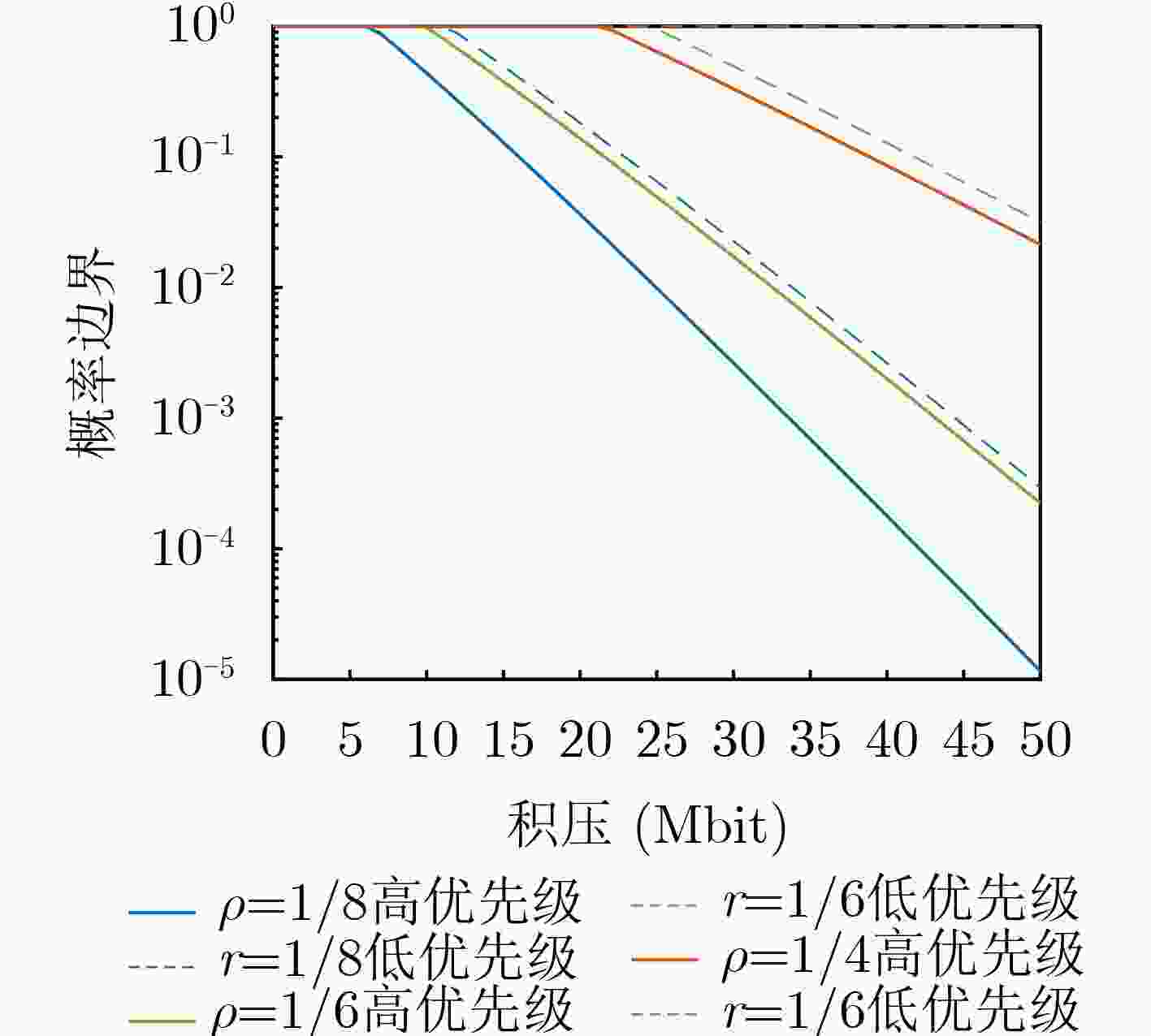Performance Analysis of Multi-hop Task Offloading of Vehicular Edge Computing Based on Stochastic Network Calculus
-
摘要: 车联网(IoV)边缘计算通过在网络边缘部署计算资源,可为车载用户提供低时延服务。该文通过随机网络演算(SNC)矩母函数(MGF)法分析车联网移动边缘计算的时延和数据积压性能。首先,分别对车辆高优先级和低优先级业务到达过程、单跳毫米波通信服务过程和边缘计算服务过程进行数学建模;其次,由服务级联定理获得不同优先级业务在多跳网络中的服务过程及其矩母函数表达式;接着,推导了车辆边缘网络不同优先级业务毫米波多跳通信任务卸载的时延和数据积压概率边界闭式解;最后通过蒙特卡罗仿真验证闭式解的准确性。Abstract: The Internet of Vehicles(IoV) edge computing can provide low-latency services for vehicle users by deploying computing resources at the edge of the network. In this paper, the delay and data backlog performance of vehicular edge computing of the IoV are analyzed by the Moment-Generating Function(MGF) method of Stochastic Network Calculus(SNC) theory. Firstly, mathematical models of the arrival process of high-priority and low-priority tasks, the single-hop millimeter-wave communication service process, and the edge computing service process are established, respectively; Secondly, according to the service cascade theorem, the service process and the moment-generating function expression of different priority tasks of vehicles in the multi-hop network are obtained. Then, the closed-form solutions of delay and data backlog probability bounds of vehicle tasks with different priorities being completely offloaded to the edge server in millimeter-wave multi-hop communication are derived. Finally, the performance of the closed-form solution is verified by Monte Carlo simulation.
-
表 1 车联网参数设置
参数名称及符号 数值 信道带宽 B 2.16 GHz 发射功率 p 5 mW 调度时隙 $ {T^S} $ 50 ms 时隙 T 2 ms 导频传输时间 $ {T_p} $ 0.01$ {T^S} $ 噪声功率密度 $ {N_0} $ –174 dBm/Hz 旁瓣增益 g 0.1 接收端主瓣波束宽度 ${\varPsi ^{\rm{R}}}$ 25° 高优先级业务数据包大小$ {\alpha _h} $ 8 Mbit 低优先级业务数据包大小$ {\alpha _l} $ 8 Mbit 发射端主瓣波束宽度 ${\varPsi ^{\rm{T}}}$ 25° 扇区级波束带宽 φ 45° VEC服务器计算容量 C 10000 Mbit/时隙 -
[1] XU Yongjun, GUI Guan, GACANIN H, et al. A survey on resource allocation for 5G heterogeneous networks: Current research, future trends, and challenges[J]. IEEE Communications Surveys & Tutorials, 2021, 23(2): 668–695. doi: 10.1109/COMST.2021.3059896 [2] YANG Zhaohui, PAN Cunhua, WANG Kezhi, et al. Energy efficient resource allocation in UAV-enabled mobile edge computing networks[J]. IEEE Transactions on Wireless Communications, 2019, 18(9): 4576–4589. doi: 10.1109/TWC.2019.2927313 [3] CHEN Mingzhe, YANG Zhaohui, SAAD W, et al. A joint learning and communications framework for federated learning over wireless networks[J]. IEEE Transactions on Wireless Communications, 2021, 20(1): 269–283. doi: 10.1109/TWC.2020.3024629 [4] JIANG Yong and LIU Yuming. Stochastic Network Calculus[M]. London: Springer, 2008. [5] AL-ZUBAIDY H, LIEBEHERR J, and BURCHARD A. Network-layer performance analysis of multihop fading channels[J]. IEEE/ACM Transactions on Networking, 2016, 24(1): 204–217. doi: 10.1109/TNET.2014.2360675 [6] SCHIESSL S, GROSS J, SKOGLUND M, et al. Delay performance of the multiuser MISO downlink under imperfect CSI and finite-length coding[J]. IEEE Journal on Selected Areas in Communications, 2019, 37(4): 765–779. doi: 10.1109/JSAC.2019.2898759 [7] CHEN Yunpei, ZHU Qi, FENG Chunyang, et al. Analysis of backlog and delay in downlink power-domain non-orthogonal multiple access wireless networks[J]. Computer Communications, 2021, 166: 26–39. doi: 10.1016/j.comcom.2020.11.005 [8] 喻莉, 罗晶晶, 姜烈, 等. 基于随机网络演算的无线多跳网延迟边界分析[J]. 电子与信息学报, 2013, 35(4): 933–938. doi: 10.3724/SP.J.1146.2012.01029YU Li, LUO Jingjing, JIANG Lie, et al. Stochastic delay boundary analysis of multi-hop wireless networks based on stochastic network calculus[J]. Journal of Electronics &Information Technology, 2013, 35(4): 933–938. doi: 10.3724/SP.J.1146.2012.01029 [9] 高月红, 李岚, 张欣, 等. URLLC业务概率时延约束及资源预留的分析与研究[J]. 北京邮电大学学报, 2018, 41(5): 98–102. doi: 10.13190/j.jbupt.2018-155GAO Yuehong, LI Lan, ZHANG Xin, et al. Analysis and research on the probabilistic delay constraint and resource reservation for URLLC traffic[J]. Journal of Beijing University of Posts and Telecommunications, 2018, 41(5): 98–102. doi: 10.13190/j.jbupt.2018-155 [10] XIONG Kai, LENG Supeng, HUANG Chongwen, et al. Intelligent task offloading for heterogeneous V2X communications[J]. IEEE Transactions on Intelligent Transportation Systems, 2021, 22(4): 2226–2238. doi: 10.1109/TITS.2020.3015210 [11] YANG Guang, XIAO Ming, AL-ZUBAIDY H, et al. Analysis of millimeter-wave multi-hop networks with full-duplex buffered relays[J]. IEEE/ACM Transactions on Networking, 2018, 26(1): 576–590. doi: 10.1109/TNET.2017.2786341 [12] CHEN Xiaosha, LENG Supeng, HE Jianhua, et al. Deep-learning-based intelligent intervehicle distance control for 6G-enabled cooperative autonomous driving[J]. IEEE Internet of Things Journal, 2021, 8(20): 15180–15190. doi: 10.1109/JIOT.2020.3048050 [13] WU Yu, YAN Li, and FANG Xuming. A low-latency content dissemination scheme for mmWave vehicular networks[J]. IEEE Internet of Things Journal, 2019, 6(5): 7921–7933. doi: 10.1109/JIOT.2019.2907119 [14] 3GPP R1–1809335. LTE Uu support for advanced V2X use cases[S]. 2018. [15] PERFECTO C, SER J D, and BENNIS M. Millimeter-wave V2V communications: Distributed association and beam alignment[J]. IEEE Journal on Selected Areas in Communications, 2017, 35(9): 2148–2162. doi: 10.1109/JSAC.2017.2719998 [16] HE Ruisi, RENAUDIN O, KOLMONEN V M, et al. A dynamic wideband directional channel model for vehicle-to-vehicle communications[J]. IEEE Transactions on Industrial Electronics, 2015, 62(12): 7870–7882. doi: 10.1109/TIE.2015.2459376 [17] BELBACHIR H and BENCHERIF F. Linear recurrent sequences and powers of a square matrix[J]. Integers, 2006, 6(A12): 17. -






 下载:
下载:







 下载:
下载:
